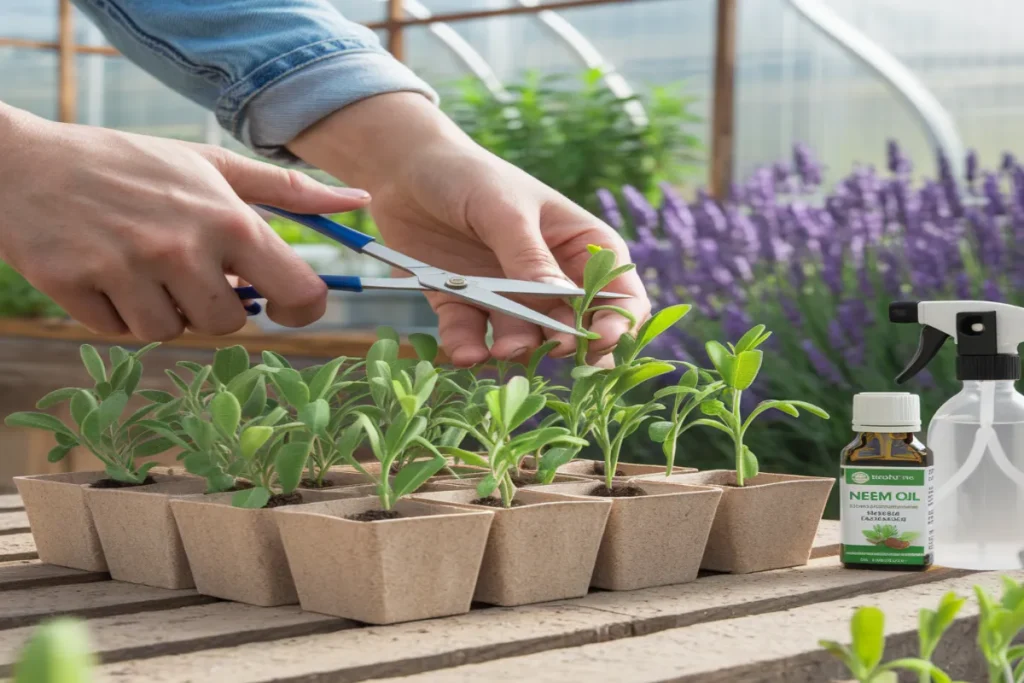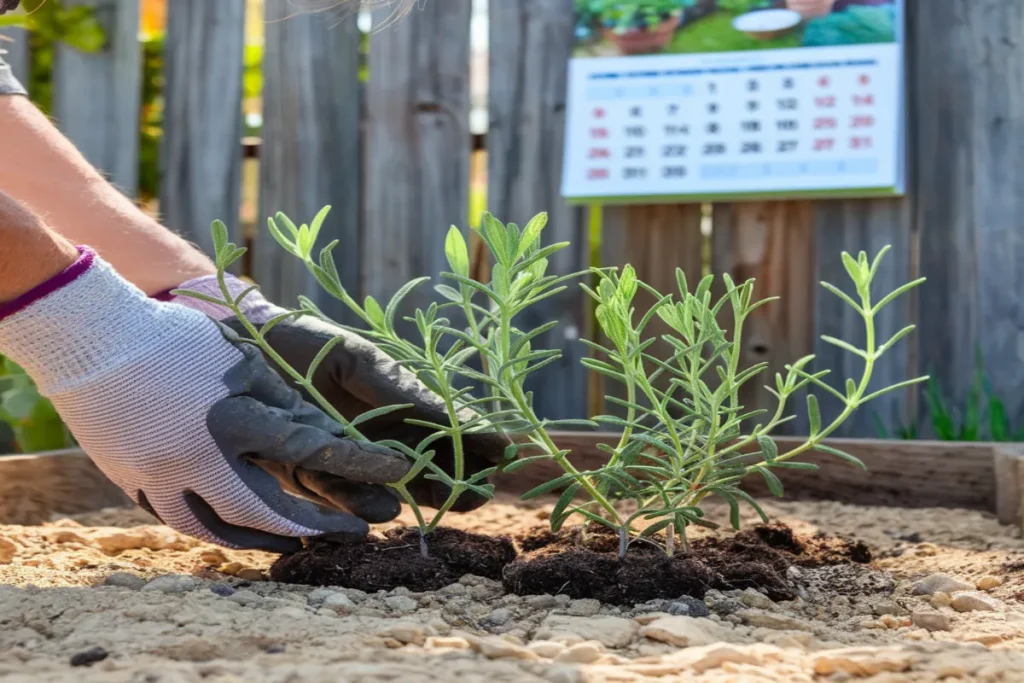Sarah Thompson’s small herb garden transformation began with a single packet of lavender seeds and a dream of creating a fragrant Mediterranean-inspired landscape. Her journey into growing lavender seedlings revealed the delicate art of nurturing these remarkable plants from tiny seeds to flourishing botanical treasures.
They represent more than just a gardening project – they are a gateway to understanding the intricate world of herb cultivation. Growing lavender from seed requires patience, precision, and a deep appreciation for botanical nuance. Gardeners eager to explore lavender propagation will discover a rewarding path to creating stunning, aromatic landscapes.
Germinating lavender seeds is a delicate process that demands specific environmental conditions. The success of lavender seedlings depends on precise temperature control, appropriate light exposure, and meticulous care during the early stages of growth. Temperatures around 70°F provide the optimal environment for seeds to sprout, typically taking 14 to 28 days to emerge.
This comprehensive guide will unlock the secrets of lavender seedling cultivation. Readers will learn essential techniques for selecting varieties, understanding germination requirements, and nurturing healthy plants from their earliest stages. Whether you’re a novice gardener or an experienced botanist, mastering the art of growing lavender seedlings opens up a world of aromatic possibilities.
Table of Contents
What Are Lavender Seedlings?
They represent the delicate beginning of a beautiful and aromatic plant journey. These tiny green sprouts emerge from minuscule seeds, marking the initial stage of growth for lavender plants. Understanding lavender sprouts is crucial for gardeners seeking to cultivate these fragrant herbs successfully.
Definition and Importance
They are young plants that develop from seeds during the early stages of growth. How to grow lavender plants from seeds requires patience and specific care. These delicate sprouts are the foundation of mature lavender plants, demanding careful attention to ensure their healthy development.
Lavender germination time can range from two to four weeks, testing a gardener’s patience and dedication.
Types of Lavender Seedlings
Different lavender varieties offer unique characteristics for gardeners to explore. Some popular types include:
- Lavandula angustifolia (English Lavender)
- Lavandula stoechas (Spanish Lavender)
- Lavandula x intermedia (Lavandin)
| Variety | Germination Time | Growth Characteristics |
|---|---|---|
| English Lavender | 14-28 days | Cold-hardy, classic fragrance |
| Spanish Lavender | 21-35 days | Tolerates warmer climates |
| Lavandin | 20-30 days | Hybrid with larger blooms |
Gardeners should note that lavender seedlings require specific conditions to thrive. The optimal germination temperature ranges between 65°F and 75°F, with seeds needing light to successfully sprout. Patience is key, as these delicate plants typically take 10-12 weeks before they’re ready for outdoor transplanting.
Choosing the Right Lavender Seedlings
Selecting the perfect lavender seedlings requires careful consideration of your specific growing environment and gardening goals. When starting lavender from seed, understanding the unique characteristics of different varieties becomes crucial for successful cultivation.
Growing them offers gardeners a delightful opportunity to explore the diverse world of these fragrant plants. Each variety brings its own special qualities to your garden, making the selection process both exciting and important.
Popular Lavender Varieties
Lavender enthusiasts have multiple varieties to choose from when learning how to plant lavender seedlings. Here are some standout options:
- English Lavender (Lavandula angustifolia): Classic variety with intense fragrance
- French Lavender (Lavandula stoechas): Thrives in hot, humid climates
- Spanish Lavender: Ideal for drought-resistant gardens
| Variety | Height | Climate Preference | Bloom Period |
|---|---|---|---|
| English Lavender | 12-36 inches | USDA Zone 5-9 | Late Spring/Early Summer |
| Spanish Lavender | 15-24 inches | Hot regions like Texas | Mid-Summer |
| Lavandin Hybrid | 24-48 inches | Moderate climates | Summer |
Growing Conditions for Different Species
When learning how to grow lavender from seed indoors, understanding specific growing requirements is essential. Different lavender species demand unique environmental conditions:
- Full sun exposure (6-8 hours daily)
- Well-drained, slightly alkaline soil
- Low to moderate water requirements
- Protection from extreme cold
“Success with lavender begins with matching the right variety to your specific microclimate and garden conditions.” – Lavender Cultivation Expert
How to Grow Lavender Seedlings
Growing lavender from seed requires patience and precision. Tips for growing lavender from seed start with understanding the delicate nature of these aromatic plants. Gardeners should know that how long it takes for lavender to sprout can vary depending on specific growing conditions.
The 1 week lavender seedling stages begin with careful seed preparation. English lavender remains the most popular variety for seed propagation, with a germination period that can extend up to one month.
Planting Techniques and Spacing
- Sow seeds on top of moist, well-draining soil
- Barely cover seeds, as they require light to germinate
- Maintain soil temperature between 65-75°F
- Plant seeds approximately two inches apart
- Consider cold stratification for 30-40 days before planting
Pro tip: Expect to sow 50-60% more seeds than your desired plant count to account for potential germination challenges.
Watering and Nutrient Requirements
Lavender seedlings demand specific care. They thrive in slightly alkaline, well-draining soil and require minimal nutrients. Avoid over-fertilizing, as lavender prefers lean soil conditions.
“Patience is key when growing lavender from seed – nature cannot be rushed.”
Ensure seedlings receive at least six hours of direct sunlight daily. Once seedlings reach two inches in height, they can be transplanted to larger containers or outdoor spaces when daily temperatures consistently reach 65°F.
Caring for Lavender Seedlings

Growing healthy lavender seedlings requires careful attention to their unique needs. Understanding how long lavender takes to germinate and recognizing what they look like are crucial first steps in successful cultivation.
Pruning for Healthy Growth
Proper pruning is essential for lavender seedling development. Gardeners should follow these key guidelines:
- Pinch back green branches every couple of weeks during the first year
- Avoid flowering in the first year to promote root and branch growth
- Prune approximately 2/3 of the plant’s height after first flowering
- Cut just above the bottom two sets of leaves on each stem
Pest and Disease Management
Lavender seedlings are vulnerable to various challenges during lavender germination. Preventative care is critical for maintaining plant health.
| Pest/Disease | Prevention Strategy | Treatment |
|---|---|---|
| Whiteflies | Weekly organic insecticidal soap treatment | Neem oil application |
| Root Weevils | Maintain good soil drainage | Beneficial nematodes |
| Damping Off | Ensure proper air circulation | Avoid overwatering |
Remember: Healthy roots are the foundation of robust, long-lasting lavender plants.
By implementing these care strategies, gardeners can nurture lavender seedlings into thriving, aromatic plants that will enhance gardens for years to come.
Best Soil for Lavender Seedlings
Growing successful lavender seedlings starts with understanding the perfect soil environment. Lavender plants demand specific soil conditions that support their unique growth requirements. When learning how to plant lavender seeds indoors, soil composition becomes a critical factor in ensuring healthy germination and plant development.
Soil Composition Essentials
The ideal soil for them should be well-draining and slightly alkaline. A perfect mix typically includes:
- 45% mineral matter
- 5% organic matter
- 50% pore space for optimal root respiration
pH Levels and Drainage
For successful lavender plant germination, maintain a soil pH between 6.5 and 8.5. When cultivating lavender seeds indoors, create a soil mix that mimics their natural Mediterranean habitat:
- 3 parts potting soil
- 1 part clay pebbles
- 1 part pumice
Moisture and Oxygen Considerations
Understanding how long for lavender seeds to germinate requires careful attention to soil moisture. Lavender roots need approximately 21% oxygen levels for optimal growth. Excessive moisture can lead to root rot, so ensure the soil dries between waterings.
“Lavender thrives in dry conditions with exceptional drainage” – Gardening Experts
Professional gardeners recommend creating a gritty soil environment that prevents water retention while providing essential nutrients for robust lavender seedling development.
When to Plant Lavender Seedlings
Timing plays a crucial role in successfully growing lavender from seeds. Gardeners interested in cultivating these fragrant plants need to understand the optimal conditions for planting and germination.
Seasonal Planting Strategies
Understanding how long do lavender seeds take to germinate is essential for successful cultivation. Lavender seeds typically require 15 to 20 days to germinate, with some varieties taking up to 28 days. The fastest way to germinate lavender seeds involves creating ideal environmental conditions.
- Start seeds indoors between early February and late August
- Plant seeds 10 weeks before the last expected frost date
- Maintain soil temperatures between 70 and 80ºF
Indoor vs. Outdoor Seed Starting
When to start lavender seeds indoors depends on your local climate. Indoor seed starting provides better control over germination conditions. Gardeners should follow these key guidelines:
- Use a seed-starting tray with well-draining soil
- Cover seeds lightly with 1/8 inch of soil
- Provide consistent moisture without waterlogging
| Planting Method | Germination Time | Optimal Conditions |
|---|---|---|
| Indoor Seed Starting | 15-28 days | 70-80ºF, consistent moisture |
| Outdoor Planting | 20-30 days | Temperatures above 55°F, full sun |

Pro tip: Ensure seedlings have at least two sets of true leaves before transplanting outdoors.
Patience is key when growing lavender from seeds. Seedlings typically take 4 to 6 weeks after germination before they’re ready for outdoor transplanting.
Frequently Asked Questions
How long does it take to grow lavender from seed?
Lavender seeds take 2-4 weeks to germinate and about 3 months to grow into seedlings big enough for transplanting. It can take 1-3 years for the plants to fully mature and reach their best blooming stage.
Why is it so hard to grow lavender from seed?
Lavender seeds are slow to germinate and need the right conditions to grow. Here’s why it’s tricky:
❌ They need light to germinate – You can’t bury them too deep.
❌ Slow growth – Even after sprouting, seedlings take months to strengthen.
❌ Temperature-sensitive – They need warm soil (65-70°F) to germinate.
❌ Not always true to type – Some varieties don’t grow the same as the parent plant.
Can I just scatter lavender seeds?
Not really. Lavender seeds need light, warmth, and well-drained soil to sprout. For best results:
✔ Surface-sow the seeds – Press them lightly into the soil without burying them.
✔ Keep soil moist but not soggy – Use a spray bottle to avoid washing them away.
✔ Provide warmth – A sunny windowsill or heat mat helps.
✔ Be patient! – Germination can take 2-4 weeks.
How big should lavender seedlings be before transplanting?
They should be at least 3 inches tall and have several sets of true leaves before moving them to a bigger pot or garden. Their roots should be strong enough to handle the move.
Does lavender bloom the first year from seed?
Sometimes, but not always. If planted early indoors (January-February), lavender may bloom lightly in the first year. However, full flowering usually starts in the second year once the plant is fully established.
Does lavender come back every year?
Yes! Lavender is a perennial, meaning it returns year after year in most climates. In colder zones, English lavender (Lavandula angustifolia) survives better than French or Spanish varieties. If winters are harsh, mulch around the base to protect the roots.

